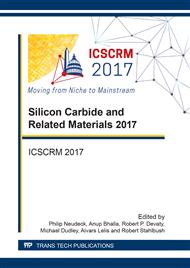p.731
p.735
p.739
p.743
p.748
p.752
p.756
p.761
p.765
Role of Trench Bottom Shielding Region on Switching Characteristics of 4H-SiC Double-Trench Mosfets
Abstract:
The effect of a gate trench bottom p+ region (BPR) on the dynamic characteristics of 4H-SiC double-trench MOSFETs was investigated. Although employing a BPR led to an improved trade-off in the static characteristics, a BPR adversely affected the switching characteristics in spite of a reduction in the Miller capacitance compared to the case without a BPR. Simulation analysis revealed that a resistance between a BPR and a source electrode led to an increase in the switching loss. We have found reduction of the resistance is insufficient in order to provide benefits from the BPR. Hence, it is necessary to improve layouts of contacts of the BPR to the source electrode.
Info:
Periodical:
Pages:
748-751
Citation:
Online since:
June 2018
Keywords:
Price:
Сopyright:
© 2018 Trans Tech Publications Ltd. All Rights Reserved
Share:
Citation:


